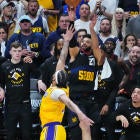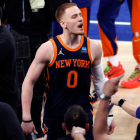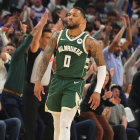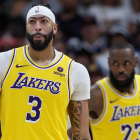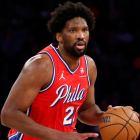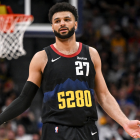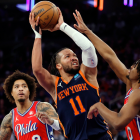MORE: 1994's Forgotten Finals: Rockets vs. Knicks | O.J. took center stage
The key matchup of the 1994 NBA Finals was undoubtedly the center position between Patrick Ewing and Hakeem Olajuwon. In a game often dominated and highlighted by giants on the hardwood, this was the best matchup possible in the NBA Finals, especially with Michael Jordan briefly retired for the first time. The New York Knicks' path to the Finals was going through the Nets, Bulls, and Pacers before meeting up with a Houston Rockets team that had dispatched of the Blazers, Suns, and Jazz.
The league was getting two of the best big men in the game, at the top of their games, and the center matchup hearkened back to the vintage playoff battles between top pivot men in the game. What made the center battle so incredible in this series was the versatility Ewing and Olajuwon had in their respective offensive games. They could really do it all on that end of the floor, and considering they were both incredible defensive centers, being able to use that offensive versatility was the key to success.
Heading into the 1994 NBA Finals, the accolades were piling up for these two big men. Ewing was an eight-time All-Star, an All-NBA guy (First team once, Second team five times), and an All-Defense center (Second team three times). Olajuwon was even more decorated. He was the MVP of the league, a nine-time All-Star, was twice Defensive Player of the Year (including that season), All-NBA eight times (five First team, two Second team, one Third team), and All-Defense seven times (five First team, two Second team).
How were these two leaders going to score against each other and generate offense for their teams? Let's take a look at how they played:
Patrick Ewing's offensive game
There wasn't much Ewing couldn't do for the Knicks during this time. That season he averaged 24.5 points on 49.6 percent from the field. He and Charles Oakley combined to dominate the boards on both ends of the floor. Ewing could also make his free throws and the extra pass to keep the offense flowing.
Let's start with the way Ewing passed in that matchup. He only had 12 assists in the series, but he did a great job of recognizing the double team and moving it to the open player or the guy who was ready to make the next pass.
In this era of basketball, help defense was a huge gamble. You weren't allowed to cheat into an area in which there wasn't an offensive player standing. You had to be within arm's length of your man or you had to be making a committed movement toward the player with the ball. It opened up great passing lanes for big men. Ewing was the type of center who would mostly make the station-to-station pass. You weren't seeing cross-court gambles all that often.
If the double came from the top, the man at the top of the key was spotting up and expecting the pass. Wherever the rotation was going to be, Ewing was trying to create a hockey assist to the opening left in the defense. He was often patient with his passing and used his length to circumvent the double-team headed his way. His patience and length in passing complemented his post game quite nicely.
Looking back at this series, it appeared the Knicks were more interested in using Ewing as a floor spreader rather than a back-to-the-basket post scorer. With Olajuwon on his back, that was probably the right move to make too. When he did post up, his strength was on display. He'd repost with deeper position than before, and he was already rooted into the low block with great position on the initial post-up. He could move into the lane with that sweeping motion or turn around to hit the jumper with his great shooting touch.
Olajuwon did a great job of bothering Ewing's shots because he was just that good defensively, as back-to-back DPOY wins would attest. However, when Ewing did manage to create space turning over that right shoulder for the jumper, it was as pure as that of any mid-range shooter in the league. He had post moves and counters. He could finish with either hand. But it was that jumper he was able to utilize that made him so tough to guard.
Even though Ewing was the primary shot taker for the Knicks, he was often a safety valve on offense as the Knicks moved the ball around. They had two or three playmakers on the floor at all times and Ewing's ability to spot-up or face-up against defenders was huge for their passing options. You weren't limited to just getting him the ball on the block. It's also amazing how the Knicks would run pin down screens for their center, something that just didn't really happen in that era. He was a good enough jump-shooter to justify such play calls.
In the series, Ewing performed well overall but he wasn't the dominant offensive force we were used to seeing. He averaged 18.8 points on just 36.2 percent shooting. He did average 12.4 rebounds and 4.2 blocks during the seven-game series, but Ewing's ability to score didn't come through the way we had seen for most of that season.
Hakeem Olajuwon's offensive game
Of course, the star of the league and the best offensive weapon in the game was Hakeem Olajuwon. He was the MVP because he had entered a zone where it seemed impossible to stop him on any given night. He had so many moves in his repertoire and a deft touch on his jumpers and passes that it was a nightmare matchup for even the best defenses in the league at the time.
It didn't start with his passing, but Hakeem knew how to recognize the double-team and move the ball better than any center in the league. It's hard to say he was the best center to ever do it, considering the exploits of Bill Walton, Arvydas Sabonis, Shaquille O'Neal, Vlade Divac, Wilt Chamberlain, and other great passing big men are well-documented. But you couldn't neutralize the Rockets' offense simply by throwing another man his way.
Olajuwon had 25 assists in those seven Finals games, recording seven assists in both a Game 3 victory and a Game 7 title-clinching win. The Rockets built their offense around the concepts of Olajuwon getting a good shot in the post, getting to the free throw line, or moving the ball to shooters spreading the floor. The Rockets weren't necessarily revolutionary in this respect but they certainly were one of the first teams to maximize this strategy.
That awareness made Hakeem a weapon from all over the court. He could pick you apart with quick passes and he could knock down jumpers. Olajuwon's strength inside and athleticism meant you couldn't bump him out of a pass or send him off-balance to where he wouldn't be able to make a play.
Olajuwon wasn't doing a ton of facing up in this series or in this era -- the Rockets wanted him with his back to the basket because of his full complement of post moves, and the fact that he was just destructive there. But I highlighted these two plays because 1) look at his handle for a 7'0" offensive virtuoso (big men weren't handling the ball like that) and 2) he could get stopped on a dribble-drive and still turn it into an easy basket.
He was just absurd with the ball.
The fun thing about this video is it's a glimpse into his repertoire on the low block. Remember that Ewing was an incredible low-post defender at this stage in his career, and even had some success in defending Olajuwon. And yet, Olajuwon still got to the spots he wanted on a lot of his moves because he was just that good. The Knicks would throw a bevy of defensive options at him. Charles Smith, Charles Oakley, and Herb Williams all had a shot at him throughout the series, and the double-teams hustled over from all angles.
None of it mattered. If he turned over his right shoulder for the fade away and you weren't in position to bother him, he was raining on your parade. If you guessed the right shoulder turn before he committed to it, you were left asking for directions to the nearest MVP center. His spin move out of the post was so quick that you were left guarding his shadow. The shoulder shakes were as hypnotic as Shakira's hips not lying. His positioning to seal off the defender and gain the advantage under the rim was impossible to recover from.
Let Olajuwon get to the baseline, and you may as well start running back down the floor on offense. He averaged 26.8 points on 50.0 percent from the field, 9.1 rebounds, 3.5 assists, and 3.8 blocks in the 1994 NBA Finals on his way to being named Finals MVP. He did that against the best defense in the league and the frontcourt most equipped to try to stifle him. None of what the Knicks did worked, because only the law of averages could stop Hakeem in those days.
It was the battle of two titans, and the better big man came out victorious. For that reason, among many, it was a Finals we shouldn't forget.













